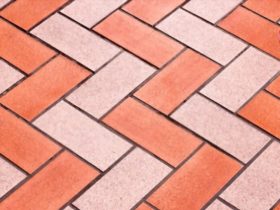There are various advantages and disadvantages to consider if you are considering tiled flooring. This type of material can be used in a variety of settings and is resistant to stains, design, and water. Because it’s a hard tile, it has several qualities that won’t function in certain situations. Understanding the benefits and drawbacks can help you determine which types of flooring is best for you.
Tiled flooring has a number of features that make it a popular option among business owners and even homes.
Pros – Simple To Care For
One of the most appealing features of tile flooring designs is its ease of maintenance. Any stains, dirt, or liquids that go on it will just sit on top of it and not absorb. This makes mopping or wiping them away from a breeze. Use a vacuum with a soft brush attachment or a broom to remove any loose debris and dirt from the floor on a regular basis. If stains do occur, practically any cleanser may be used without harming the tile flooring designs.
Many individuals choose ceramic tiled flooring in United Kingdom for their bathrooms and kitchens as a result of this. In addition to being easy to clean, the floor will not store germs. This is advantageous for operating a public-facing company, such as a restaurant.
Pros – Water-Resistance Is A Advantage
Another advantage of the tiled flooring is that it is water resistant. The material has a protective layer on top that makes it stain and water resistant. This is especially significant in bathrooms and kitchens, where the ceramic tile will endure far longer than other materials. It also withstands high humidity conditions, so you won’t have to worry about it becoming damaged during the hot and steamy summer months. Ceramic tiles will help any damp climate.
If you purchase the unglazed tile, you will need to seal it to protect it from any liquids it may come into contact with. Make sure the grout lines between the tiles are sealed because they might be vulnerable to moisture. Otherwise, water can seep deep into the tiles, weakening their installation and exposing them to mould growth. This will result in costly complications that you will have to deal with later.
Pros – Long-lasting
Tiled flooring in UK is durable, and the tiles are difficult to break. If you obtain a professional installation, the tiles can last up to 20 years or even longer if you maintain them properly. Even if one tile cracks, it’s usually due to a violent impact, and you’ll be able to easily replace it. Because you won’t have to change tiles on a regular basis, you’ll be able to keep your overall costs low.
Pros – Cost Is A Plus
The majority of individuals can afford tiled flooring in United Kingdom. The majority of tiles will cost between $5 and $10 per square foot. The cheaper ones will be made of lower-quality materials, whilst the more costly ones will be made of higher-quality materials. Tile is less costly than hardwood but more expensive than carpet. However, depending on how it is put and how it appears, tiled flooring may add long-term value to a home.
While there are numerous advantages to tiled flooring, there are also some drawbacks to be aware of.
Cons – Cold Is A Disadvantage.
Because tiled flooring does not absorb or keep heat effectively, it gets fairly chilly in the winter. When this is placed in the home, your feet will be shocked when they first tread on chilly flooring in the morning. If you’re placing tiles in a public area of your business where customers could feel uncomfortable, this is something to think about. One advantage is that it will feel amazing in the summer when people tread on the chilly floor while it is scorching outside.
Cons – Expensive
Tiled flooring is heavy, thus it’s not the ideal choice for installations on upper floors. A specialist should inspect the structure’s integrity before installing tiled flooring in UK on the upper level of a commercial location. You must ensure that you are not placing it under additional stress that it cannot bear.
Cons- Slippery And Difficult
Because of its hardness, tile flooring designs are easy to maintain, but it is not always comfortable to stand on. Tiled flooring, on the other hand, cannot be softened with cushioned underlayment. As a result, it is not the finest material for individuals who must stand for long periods of time. Area rugs or throw rugs, on the other hand, can be placed in areas where people frequently stand, such as in front of a kitchen sink or behind the cash register.
Tile flooring is slippery due to its hardness. As a business owner, you want to avoid any accidents as much as possible. As a result, this should not be put in locations where water or liquid is regularly spilt on the floor, as this might cause injury to your employees and a mess. The same is true for public restrooms since you do not want to be sued by a client who slips on the wet tiled flooring.
Tile flooring has both advantages and disadvantages. You’ll want to think about where you’re going to put it, how much money you have, and who will be walking or standing on it the most. Many people like how long it lasts and how water resistant it is, which is important in a bathroom or kitchen. Others, on the other hand, dislike the tiles’ weight and coldness. You must determine which elements are critical.
Cons – Lifespan
A well-kept tile floor can easily last 20 years or longer. A tile floor can survive for over 50 years unless the tiles are severely broken in some manner. Some old stone tile floors can still be found today, albeit they are safeguarded from further usage for the sake of preservation.
Because the tiles themselves are highly durable, the greatest concerns to the lifespan of your floor are usually grout difficulties and any problems with the subfloor (water damage, etc.). Take care to keep the grout clean and replace it as needed. Always buy additional tiles so that you can readily replace any that are damaged or buckled.
FAQs
Is it possible to put ceramic tile outside?
Yes, but only if the right sort of ceramic tile is used and put correctly. When choosing a ceramic tile for external use, one of the most significant factors to consider is the tile’s water absorption rate. A tile with a water absorption rate of 3% or less is typically suggested, with less than 0.5% (porcelain) being optimal.
If your tile collects too much water, it may be damaged, particularly if the water freezes and expands, cracking the tile. You might also want to consider a through-body unglazed porcelain tile, which means the top colour runs all the way through the tile, making chipping and damage less obvious if your outdoor tile takes a beating.
If you’re going to grout your tile outside, make sure you’re sealing it (or using sealed grout) and using expansion joints were necessary to account for water and temperature fluctuations.
Which floor tile is the most durable?
Porcelain is commonly thought of as a delicate material used to produce dolls and exquisite china. Porcelain, believe it or not, is one of the hardest varieties of tile, resistant to water, stains, pet claws, and furniture damage. Porcelain tiled flooring in United Kingdom may be a suitable choice if durability is important to you. Depending on the texture and surface you wish to create, porcelain tiling comes in both glazed and unglazed versions. Porcelain tile is also available in a variety of colours and designs, making it both durable and appealing.
Is it possible to repair or stain porcelain tiled flooring?
Hardwood floors may be stained or refinished, as you already know. However, did you know that the same approaches may be used to alter the appearance of porcelain tiled flooring?
The ultimate outcome is the same, regardless of the process: a deeper hue and a glossier surface. However, be aware that staining and refinishing is a time-consuming and tough task, especially when working with porcelain. Request assistance from a professional tiled flooring installation crew for long-lasting, high-quality results with less stress and clutter.
How much does a tile backsplash cost?
Consider your kitchen for a moment. Consider the area between your kitchen counters and the bottoms of your cabinets. The “backsplash” is the area of the wall that is covered in tile in many homes. Tile backsplash prices vary depending on brand, materials, and style, just like any other building material. Our expert staff will pay attention to your design preferences and assist you in selecting a product that meets both your needs and your budget.















Leave a Reply